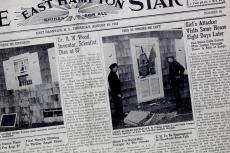The East Hampton Town Board moved on Tuesday toward adopting community choice aggregation, in which a town, or group of towns, hires an administrator to issue a competitive bid and choose a supplier for electricity, natural gas, or both.
The discussion came exactly one month after the governor’s declaration of a state of emergency, which has mostly had the board focusing on the Covid-19 pandemic.
A community choice aggregation, or C.C.A., program combines purchasing power, allowing the town or towns to negotiate lower electricity rates. It can also enable a municipality to derive its electricity from renewable sources, a goal set by East Hampton in 2014.
A public hearing must be held before implementing a C.C.A. program. Southampton Town adopted enabling legislation and selected an administrator last year.
Meeting via video conference, the town board was joined by Lauren Steinberg, an environmental analyst with the Natural Resources Department, Gordian Raacke of the advocacy group Renewable Energy Long Island, and John Jilnicki, the town attorney, all of whom sought to provide clarity to a complex subject.
The New York State Energy Research and Development Authority, Mr. Raacke said, asserts that C.C.A. “is likely the most powerful tool to reduce greenhouse gas emissions” in any municipality, because it works on behalf of an entire population. Mr. Raacke called C.C.A. “a very powerful and effective tool to reduce greenhouse gas emissions from the power sector.”
Right now the Long Island Power Authority determines where the electricity supply comes from. A C.C.A. program, Ms. Steinberg told the board, would replace LIPA as the default power supply provider, instead contracting with energy supply companies (ESCOs) for residents and businesses. Power supply options could be 100 percent renewable energy, traditional fossil-fuel energy, or a blend of the two. Individual customers would have a choice of which option they would like to purchase.
Electricity would be delivered through the existing grid. While the power supply cost may change depending on the energy source, its distribution cost would not. Customers would be able to opt out of a C.C.A. program without penalty.
More than 100 municipalities across the state, including Southampton, Brookhaven, and Hempstead, have adopted enabling legislation for C.C.A. Thirty-eight of the 61 municipalities now operating a C.C.A. program in the state are sourcing their electricity from 100 percent renewable sources. All of them are managed by one of four C.C.A. administrators, who are funded by one-tenth of a cent for every kilowatt hour that bills through the program.
LIPA must approve a C.C.A. “tariff” — terms and conditions — in its service territory in order for a program to exist. The tariff specifies how customer data will be exchanged between LIPA and the C.C.A. administrator, including schedule, data protection, and fees. The LIPA board is expected to vote on the tariff on May 20. Should it vote to approve, C.C.A. could be permitted on Long Island as soon as June 1.
Separating the purchase of electricity from the utility that distributes it “can have some definite advantages,” said Supervisor Peter Van Scoyoc. “You can encourage and incentivize renewable expansion throughout the marketplace.” Noting that Southampton has already adopted enabling legislation and selected Joule Assets of Katonah, N.Y., as the program’s administrator, “I think it certainly would be an advantage to both municipalities if we’re able to join as a buying bloc, and any others in the region,” he said. He has circulated to his colleagues a draft letter to the LIPA board encouraging it to approve C.C.A.
The cost-per-kilowatt-hour difference between fossil fuel and renewable energy for customers in the Sustainable Westchester C.C.A. program was less than one cent, Mr. Raacke said, citing figures from last summer. Aggregating municipalities’ energy needs there has generated “impressive savings over utility rates,” he said. He cautioned, however, that “that doesn’t mean we will see the same prices on Long Island.”
Mr. Raacke noted that ongoing debt related to the nuclear power plant in Shoreham, which was constructed in the 1970s but never operated, is paid through electricity delivery charges. “There’s nothing we can do about having to pay for the mistake made a long time ago,” he said. “We will be paying for that for many more years.”
Councilman Jeff Bragman said that C.C.A. represents “a big step forward for us . . . a very productive step in meeting our renewable energy goals.” It is “a very elegant solution” by which even a community representing a small fraction of LIPA’s revenue can reap the benefits of renewable energy procurement. “It really is investing in renewables,” he said. “You’re shifting purchasing toward renewables, which strengthens those markets.”
“As more and more renewable generation projects come online, costs will go down,” Mr. Van Scoyoc agreed. “By choosing 100 percent renewable, you’re also influencing that market and further influencing green energy.”
With the proliferation of renewable energy infrastructure such as offshore wind farms and solar farms, costs will continue to decline, Mr. Raacke said, reducing the differential between “green” and “brown,” or fossil-fuel, energy.
The town’s draft enabling legislation is a simple and straightforward document based on a template from NYSERDA, Mr. Jilnicki said. It allows for a blend of energy sources. “The idea of aggregating needs with other municipalities, it becomes a bigger buying bloc that hopefully leads to reduced prices,” he said. “The ability to direct where power is sourced from is a huge potential for the town to focus on more renewable energy sources.”
Passing the legislation would not commit the town to take further action, he said.



